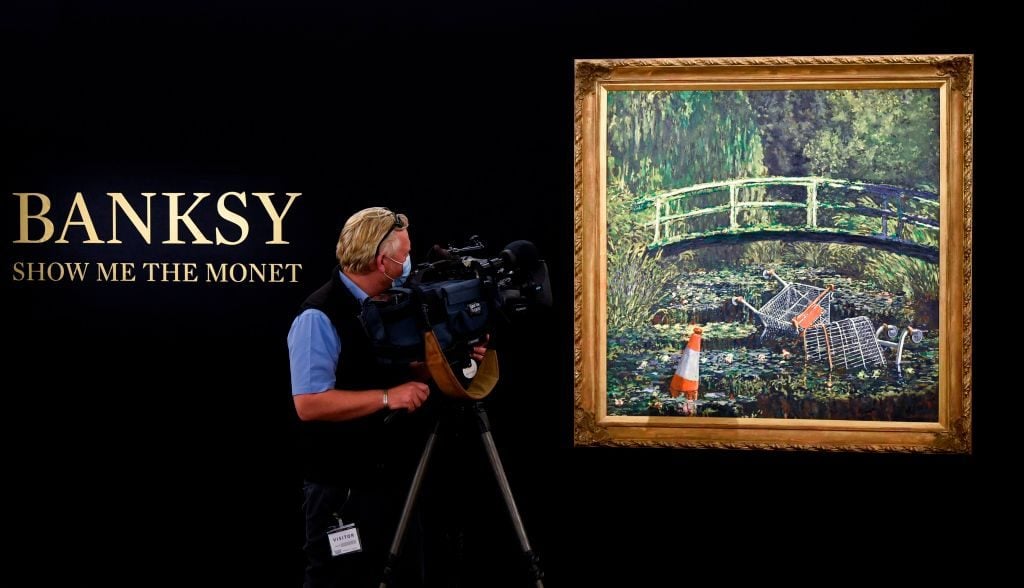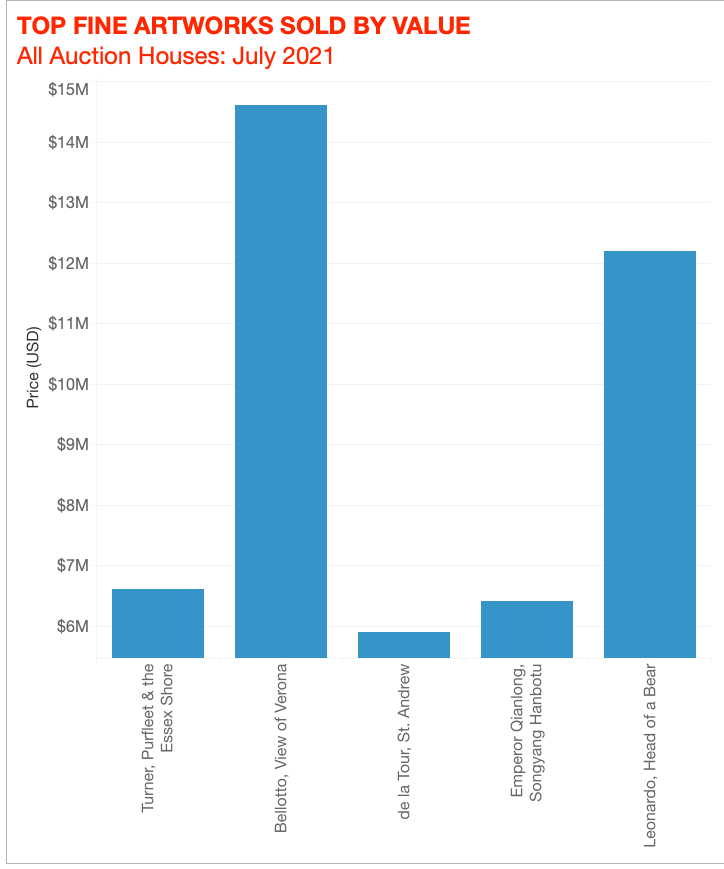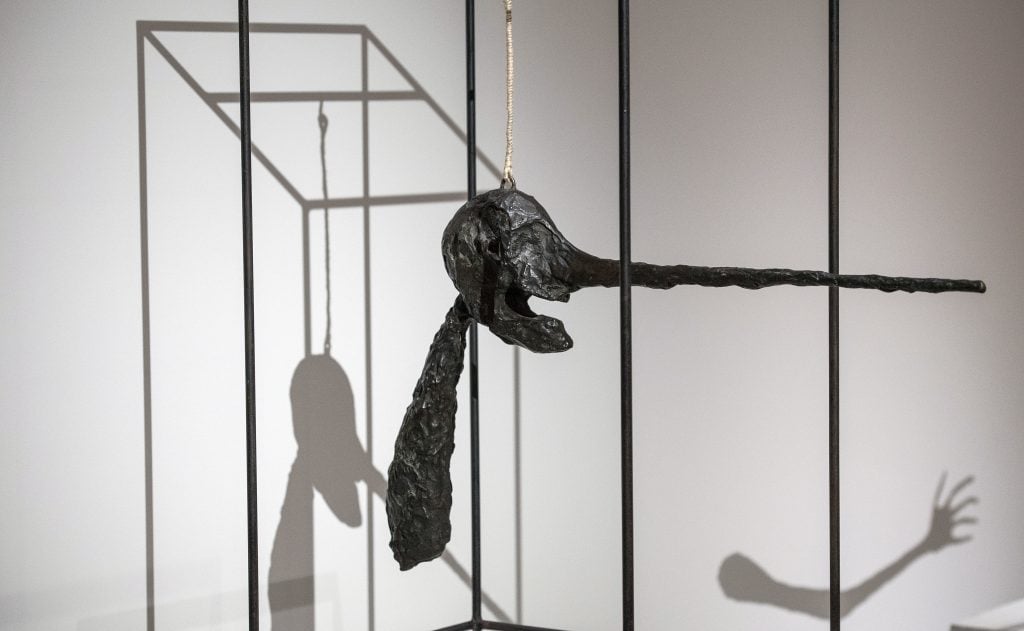The Back Room
The Back Room: Waiting on the Future
This week: A gut check on art-market innovation, July’s relaxed auction highs, the Macklowe collection (maybe, finally) in motion, and much more.

This week: A gut check on art-market innovation, July’s relaxed auction highs, the Macklowe collection (maybe, finally) in motion, and much more.

Tim Schneider

Every Friday, Artnet News Pro members get exclusive access to the Back Room, our lively recap funneling only the week’s must-know intel into a nimble read you’ll actually enjoy.
This week in the Back Room: A gut check on art-market innovation, July’s relaxed auction highs, the Macklowe collection (maybe, finally) in motion, and much more—all in a 6-minute read (1,718 words).
__________________________________________________________________________________

A television camera operator films an artwork entitled Show me the Monet by the artist Banksy during a photocall at Sotheby’s.(Photo by DANIEL LEAL-OLIVAS / AFP)
Despite the many tragedies COVID-19 caused last year, the silver lining to the once-in-a-century upheaval was supposed to be that it would spark a radical rethinking of life, politics, culture, and business. But to paraphrase funk legend Rick James in the Chappelle’s Show sketch that defined an era of comedy for old millennials, inertia has turned out to be a hell of a drug in the art market.
With our third year under the shadow of COVID just a few months away, I argued in this week’s Gray Market that it’s time to stop pretending the industry has responded to the epic challenge of the pandemic with sufficient creativity and vision for the long term.
Even the best-resourced players seem most interested in re-establishing the status quo with bare-minimum tweaks.
I had to ask: Is this really the best we can do?
It shouldn’t be. As I learned from futurist Doug Stephens’s latest book, Resurrecting Retail: The Future of Business in a Post-Pandemic World, a vanguard of forward-thinking brands is putting art-market innovation to shame with their big moves toward transformational change.
His case studies reveal a grand irony: Art sellers have largely been pirouetting away from showmanship and engagement toward mechanized, repeatable, low-friction transactions at exactly the moment future-conscious retailers are doing the exact opposite.
For example, consider…
CAMP, a toy store where toys take up only about 20 percent of the space in each brick-and-mortar location.
B & H PHOTO VIDEO, meanwhile, is an A/V superstore whose sales staff consists entirely of expert photographers uniquely fit to guide buyers through costly, often-confusing specialty purchases.
MORPHE, a next-wave cosmetics venture, has re-engineered each of its stores to double as an accessible content-production house for customers.
__________________________________________________________________________________
Since COVID has not proven to be a mass-bankruptcy event 18 months in, too many art sellers have been able to think about their strategy like frogs think about slowly boiling water: everything seems fine, until the moment it’s too late.
The examples in Resurrecting Retail aren’t necessarily turnkey solutions for the art market. But they show how much more radically some sellers are reimagining what they do in response to the original shutdown and larger trends.
If the pandemic truly ends before more of the art industry grasps how tentative its business evolutions look against the broader backdrop of retail, it won’t be the greatest tragedy of this crisis. But it will be another missed opportunity in a historical period that risks being defined by them.
__________________________________________________________________________________

Es Devlin, Forest of Us, (2021). Installation view of Every Wall is a Door, Superblue Miami, 2021. Photo: Andrea Mora.
Wet Paint will arrive later on Friday, but here’s what made a mark across the industry in the meantime…
Art Fairs
Auction Houses
Christie’s will be the first house to branch into selling profile pic non-fungible tokens (PFP NFTs) from series like CryptoPunks, Bored Ape Yacht Club, and Meebits in an online sale from September 17–28.
Galleries
Superblue will open locations in London and New York this fall.
Art House, a new venture from original TEFAF New York organizers Michael Plummer, Jeff Rabin, and George Fox, will rent flexible exhibition space to dozens of galleries, host fairs, and program events in the former Barneys New York flagship store at 660 Madison Avenue.
Los Angeles’s Nicodim Gallery will open a New York location in Soho in October with a solo show by Simphiwe Ndzube.
Institutions
Stefan Kalmár will depart as director of the Institute of Contemporary Arts, London.
Stockholm’s Moderna Museet tapped Hendrik Folkerts of the Art Institute of Chicago to be its next curator of international contemporary art.
The International Center of Photography in New York hired David E. Little to be its executive director; he had been the director and chief curator of the Mead Art Museum at Amherst College since 2016.
NFTs and More
A new gas-fee-free, allegedly carbon-neutral NFT platform called Voice has tapped Kimberly Drew, Myriam Ben Salah, and Azu Nwagbogu for its first curatorial residency.
__________________________________________________________________________________

© Artnet Price Database and Artnet Analytics 2021.
The high-end auction market no longer stops post-COVID, but it still does slow down a bit sometimes. The chart above shows the five most expensive fine artworks to sell under the hammer last month. (Some titles abbreviated for space.) Together, the quintet amassed about $45.7 million. For comparison, that’s about three-quarters less by value than June’s top five sellers ($189 million).
Interestingly, the scale of the cooldown is almost identical if you look only at each month’s priciest lot. June’s lucre leader was a work on paper by Xu Yang that sold for nearly $65 million at Poly in Beijing, including fees; July’s price king was Bernardo Bellotto’s View of Verona With the Ponte delle Navi (1745–47), which brought a premium-inclusive £10.6 million ($14.6 million) at Christie’s London—a drop of 77 percent. So whether you’re talking about consignors or buyers, it turns out that even whales still take vacations in the “new normal.”
Click through below for a closer look at all 15 top sellers around the globe in July.
__________________________________________________________________________________
“My favorite quote from one particular critic was: ‘Promoting anal sex and polyamory to fight Nazism is just another day’s work for the ICA’s press department.’”
—Stefan Kalmár, the (earlier-mentioned) departing director of the Institute of Contemporary Arts, London, recounting one of several “rightwing complaints” from the British government that convinced him electoral politics was dangerously intermixing with public arts funding in the U.K.
London’s Barbican Center will remake its executive hierarchy after the publication of a dossier documenting more than 100 alleged instances of institutional racism. (The Art Newspaper)
__________________________________________________________________________________
In other equity-meets-business news, multiple artists of color who attended last week’s festivities in Aspen agreed with featured star Precious Okoyomon that “the unbearable whiteness was too much,” an ominous sign for the city’s future as a hub in a diversity-driven art market. (Vulture)
__________________________________________________________________________________
Today in “missing the point”: an online startup claims to be selling the first NFT that certifies ownership of a Claude Monet work whose authorship has, uh, not been certified. (Artnet News Pro)
__________________________________________________________________________________
At the Bellagio Hotel on October 23, Sotheby’s will team up with MGM Resorts on an auction of Picasso works expected to make as much as $100 million. Sotheby’s and MGM call it “the largest and most significant fine art auction to ever take place in Las Vegas,” a title for which the competition seems… very beatable. (Artnet News)

Le Nez by Alberto Giacometti throwing a shadow at Schirn art hall in Frankfurt/Main, Germany. (Photo by Boris Roessler/picture alliance via Getty Images)
__________________________________________________________________________________
Date: 1949
Seller: Harry and Linda Macklowe
Estimate: $35 million to $65 million*
Selling at: T.B.D.
Sale Date: T.B.D.
At first, the price expectations for this celebrated Giacometti sculpture look like an example of my favorite auction phenomenon, in which the presale estimate range is so wide that the high estimate nearly doubles the low estimate. (We can’t narrow those down a little, folks?) But in this case the gap stems from something much more notable than indecisiveness or volatility.
This cast of Le Nez (“The Nose”) is one of the prime lots that will hit the auction block (maybe, finally, mercifully) this November from the hotly pursued but long suffering collection of Harry and Linda Macklowe. It’s also a textbook example of what a bloody turf war the jointly owned art holdings of a divorcing couple can become; the two hugely different numbers above are the dueling valuations from Harry and Linda’s respective appraisers, according to Katya Kazakina’s analysis of court papers for her deep dive into the pending court-ordered auction.
Although COVID played a role in the sale’s extended delay, the divorce has largely been held up by the couple’s contentiousness. Remember, Harry and Linda’s collection was put into the hands of a court-appointed receiver (Michael Findlay of Acquavella Galleries) partly because their teams’ valuations ran into irreconcilable differences, as Le Nez illustrates. But with the court’s three-year sale deadline looming next year, we may finally see paddles go up for the Macklowes’ trophy-packed holdings starting this fall. Katya relays that “the expectation among people familiar with the matter” is that Sotheby’s has won the consignment. (Representatives for Sotheby’s and Christie’s had no comment. Findlay didn’t respond to requests to comment.)
__________________________________________________________________________________